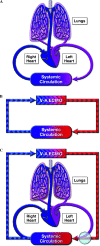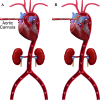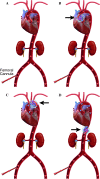Regional perfusion during venoarterial extracorporeal membrane oxygenation: a case report and educational modules on the concept of dual circulations
- PMID: 24303602
- PMCID: PMC4557539
Regional perfusion during venoarterial extracorporeal membrane oxygenation: a case report and educational modules on the concept of dual circulations
Abstract
A challenging aspect of managing patients on venoarterial extracorporeal membrane oxygenation (V-A ECMO) is a thorough understanding of the relationship between oxygenated blood from the ECMO circuit and blood being pumped from the patient's native heart. We present an adult V-A ECMO case report, which illustrates a unique encounter with the concept of "dual circulations." Despite blood gases from the ECMO arterial line showing respiratory acidosis, this patient with cardiogenic shock demonstrated regional respiratory alkalosis when blood was sampled from the right radial arterial line. In response, a sample was obtained from the left radial arterial line, which mimicked the ECMO arterial blood but was dramatically different from the blood sampled from the right radial arterial line. A retrospective analysis of patient data revealed that the mismatch of blood gas values in this patient corresponded to an increased pulse pressure. Having three arterial blood sampling sites and data on the patient's pulse pressure provided a dynamic view of blood mixing and guided proper management, which contributed to a successful patient outcome that otherwise may not have occurred. As a result of this unique encounter, we created and distributed graphics representing the concept of "dual circulations" to facilitate the education of ECMO specialists at our institution.
Keywords: ECMO, education, cardiopulmonary bypass, cannulation.
Conflict of interest statement
The senior author has stated that the authors have reported no material, financial, or other relationship with any healthcare-related business or other entity whose products or services are discussed in this paper.
Figures





Similar articles
-
[Extracorporeal membrane oxygenation treatment of a neonate with severe low cardiac output syndrome following open heart surgery].Zhonghua Er Ke Za Zhi. 2008 Jan;46(1):26-9. Zhonghua Er Ke Za Zhi. 2008. PMID: 18353234 Chinese.
-
Regional variation in arterial saturation and oxygen delivery during venoarterial extracorporeal membrane oxygenation.J Extra Corpor Technol. 2013 Sep;45(3):183-6. J Extra Corpor Technol. 2013. PMID: 24303601 Free PMC article.
-
Extracorporeal lung support technologies - bridge to recovery and bridge to lung transplantation in adult patients: an evidence-based analysis.Ont Health Technol Assess Ser. 2010;10(5):1-47. Epub 2010 Apr 1. Ont Health Technol Assess Ser. 2010. PMID: 23074408 Free PMC article.
-
How I manage differential gas exchange in peripheral venoarterial extracorporeal membrane oxygenation.Crit Care. 2023 Oct 27;27(1):408. doi: 10.1186/s13054-023-04703-3. Crit Care. 2023. PMID: 37891688 Free PMC article. Review.
-
Venoarterial Extracorporeal Membrane Oxygenation as a Bridge to Recovery or Bridge to Heart Replacement Therapy in Refractory Cardiogenic Shock.Curr Heart Fail Rep. 2020 Dec;17(6):341-349. doi: 10.1007/s11897-020-00495-7. Epub 2020 Oct 24. Curr Heart Fail Rep. 2020. PMID: 33098525 Review.
Cited by
-
Subtypes and Mechanistic Advances of Extracorporeal Membrane Oxygenation-Related Acute Brain Injury.Brain Sci. 2023 Aug 4;13(8):1165. doi: 10.3390/brainsci13081165. Brain Sci. 2023. PMID: 37626521 Free PMC article. Review.
-
Ultrasonographic assessment of aortic flow characteristics in a paediatric patient with sepsis treated with extracorporeal life support: defining the mixing zone.Australas J Ultrasound Med. 2020 Jun 18;23(4):255-263. doi: 10.1002/ajum.12206. eCollection 2020. Australas J Ultrasound Med. 2020. PMID: 34760604 Free PMC article.
-
Hemodynamic Monitoring During Liver Transplantation for Patients on Perioperative Extracorporeal Membrane Oxygenation (ECMO) Support: A Narrative Review.Medicina (Kaunas). 2025 Apr 21;61(4):768. doi: 10.3390/medicina61040768. Medicina (Kaunas). 2025. PMID: 40283059 Free PMC article. Review.
-
Esmolol Corrects Severe Hypoxemia in Patients with Femoro-Femoral Venoarterial Extracorporeal Life Support for Lung Transplantation.J Extra Corpor Technol. 2016 Sep;48(3):113-121. J Extra Corpor Technol. 2016. PMID: 27729704 Free PMC article.
-
Watershed phenomena during extracorporeal life support and their clinical impact: a systematic in vitro investigation.ESC Heart Fail. 2020 Aug;7(4):1850-1861. doi: 10.1002/ehf2.12751. Epub 2020 Jun 12. ESC Heart Fail. 2020. PMID: 32530129 Free PMC article.
References
-
- Paden ML, Conrad SA, Rycus PT, Thiagarajan RR.. Extracorporeal Life Support Organization registry report. ASAIO J. 2013;59:202–210. - PubMed
-
- Peek GJ, Mugford M, Tiruviopati R, et al. . Efficacy and economic assessment of Conventional Ventilatory Support versus Extracorporeal Support for Severe Adult Respiratory Failure (CESAR): A multicentre randomized controlled trial. Lancet. 2009;374:1351–1363. - PubMed
-
- Riley JB, Scott PD, Schears GJ.. Update of safety equipment for extracorporeal life support (ECLS) circuits. Semin Cardiothorac Vasc Anesth. 2009;13:138–145. - PubMed
Publication types
MeSH terms
LinkOut - more resources
Full Text Sources
Research Materials
